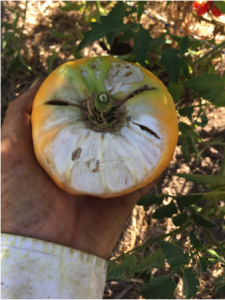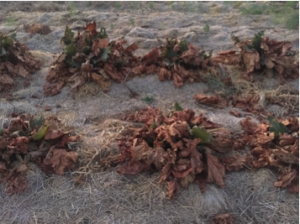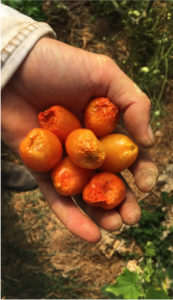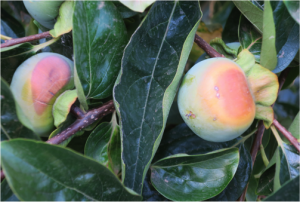



Climate Experience:
Local growers findings their crops are struggling to survive the persistent heat of January 2019.
Reports include:
- Beans – burnt and dying
- Cucumbers – normally 4 per day per plant, now 1-2 per week
- Pumpkins – struggling to survive
- Tomatoes – low numbers, normally harvest 1kg per day, now only cherry tomatoes have set fruit. Large varieties are either dead or did not flower/set fruit
- Cherry tomatoes – dehydrated
- Rhubarb – all leaves dried, only bulbs remain alive, unlikely to get another crop until next season
- Zucchini – low numbers, normally harvest 2 zucchinis per day, now only 1-2 per week
- Berries – dying on the bush
- Grapes – some drying on the vine
- Persimmons – burnt
Explanation:
- Extreme heat can damage crops.[1]
- Most fruit and vegetables have a maximum temperature threshold between 24-35 degrees.[2]
- January 2019 had a mean average of 37.4 degrees,[3]almost 6 degrees above the long term average.[4]
- The region has been getting hotter with 20 out of the past 21 years seeing above average temperatures.[5]
Ramifications:
- Current emission scenarios will see number of over 35 degree days increase by 30% in Victoria.[6]
- Farmers will find it harder to grow fruit and vegetables and consumers will pay more for produce.[7]
- Heat and drought may contribute levels of plant susceptibility to pathogens however not all crops will respond in the same way.[8]
What can be done?
- Email your local MP and tell them that action on climate is important to you and explain the impacts being felt in your area. One email might not feel like much but most politicians consider it to be representative of 100 citizens.
- Get involved with local groups taking action on climate, in this community look out for Wodonga Albury Towards Climate Health (WATCH) group.
- Help support the Act on Climate collective by donating; we are leading the charge for climate action. Your donation helps in advancing policies that prevent climate change from getting worse, we aim to empower communities and build a strong pro-climate-action constituency that governments can’t ignore, and as an added bonus it’s tax-deductable.
- Get involved with Act on Climate. We meet every Monday at 6pm (upstairs at 312 Smith St, Collingwood) and welcome all newcomers to join in the fight for climate justice. If you are unable to attend, follow us on Facebook, Twitter, and Instagram to keep up with the latest campaign.
* We aim to keep our material as accurate and as relevant as possible. Working with climate science, a field that is being constantly updated, keeps us on our toes. Information on this site was gathered on June 1 2019; if you notice information that needs updating please let us know. For the full reference list please see the following.
____________________________
[1]Craita Bita and Tom Gerats, “Plant Tolerance to High Temperature in a Changing Environment: Scientific Fundamentals and Production of Heat Stress-Tolerant Crops,” Frontiers in plant science4 (2013).
[2]Robert Anthony Sudmeyer et al., “Climate Change: Impacts and Adaptation for Agriculture in Western Australia,” (2016).54.
[3]“Albury-Wodonga January 2019 Daily Weather Observations”, Bureau of Meteorology, published April 17 2019, http://www.bom.gov.au/climate/dwo/201901/html/IDCJDW2002.201901.shtml
[4]“Wodonga Climate”, Weather Zone, accessed April 23 2019, http://www.weatherzone.com.au/climate/station.jsp?lt=site&lc=82056
[5]“Australian Climate Change Site Data – Rutherglen”, Bureau of Meteorology, access April 23 2019, http://www.bom.gov.au/cgi-bin/climate/hqsites/site_data.cgi?variable=maxT&area=aus&station=082039&dtype=anom&period=annual&ave_yr=0
[6]Ross Garnaut, “The Garnaut Climate Change Review,”Cambridge, Cambridge (2008).117.
[7]Peter Deuter, “Defining the Impacts of Climate Change on Horticulture in Australia,” (2008).17.
[8]Sudmeyer et al., “Climate Change: Impacts and Adaptation for Agriculture in Western Australia.”, 80.
